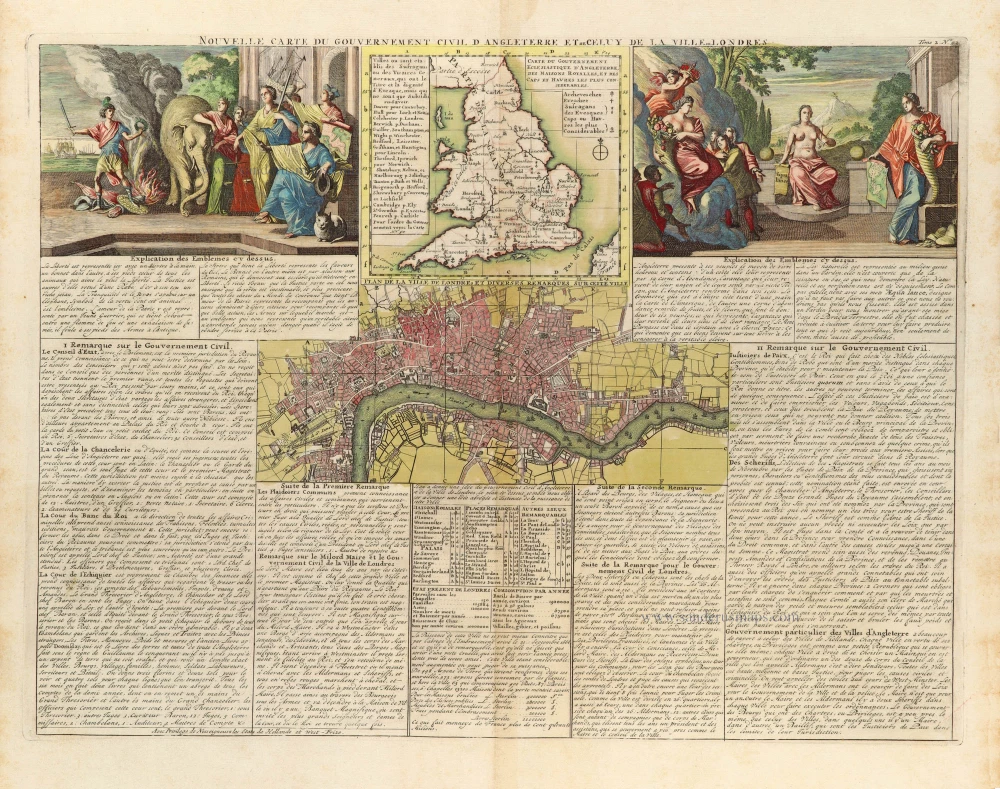London, by François de Belleforest. 1575
The Cosmographie Universelle of F. de Belleforest was published in a shared edition by Nicolas Chesneau and Michel Sonnius. The objective of the two partners was to reprint Sébastien Münster's Cosmographie in French. Münster's work, published in Basel in 1544, had indeed been a great success and had known multiple reissues. It had been published in French in 1552, but Chesneau and Sonnius, noting that Münster had mainly treated his own country, Germany, wanted to satisfy the tastes of their compatriots more.
They appealed for the text of the work to François de Belleforest (1530-1583). Belleforest probably helped Chesneau and Sonnius in their quest for new city plans.
Belleforest's Cosmographie is presented in two parts, the first of which is divided into two volumes; each of the three volumes has its own title. Some copies bear the imprint of Chesneau and others that of Sonnius.
Of the 163 plates in the Cosmographie, only 49 are copied from the work of Sebastian Münster. Little is known about the engravers of the Cosmographie. The name of Cruche appears only once, at the bottom of the plate of Paris. Raymont Rancurel is the second known engraver in the Cosmographie. In 1572 appeared, the first volume of the Civitates Orbis Terrarum of Braun and Hogenberg. Twenty of these plates were copied by the Cosmographie of Belleforest. On the other hand, the later volumes of the Civitates borrowed eleven cities from Belleforest's work. From the Theatrum Orbis Terrarum of Abraham Ortelius (1570), Chesneau and Sonnius have retained more modern maps than those of Münster. Other plans have been copied from the Plantz and Pourtraitz by Antoine Du Pinet or from the small maps of Camocio.
Londinum, Feracissimi Agliae Regni Metropolis. [French title above map:] La Ville de Londres.
Item Number: 27163 Authenticity Guarantee
Category: Antique maps > Europe > British Isles - Cities
Old, antique bird's-eye view plan of London, by de François de Belleforest.
Date of the first edition: 1575
Date of this map: 1575
Woodcut, printed on paper.
Size (not including margins): 30.5 x 48.5cm (11.9 x 18.9 inches)
Verso: Blank
Condition: Old reinforcement at lower centrefold split, waterstain at lower centre.
Condition Rating: A
References: Pastoureau, Belleforest I-1 [4]; Howgego, #3.
From: La Cosmographie Universelle de tout le Monde. Paris, Nicolas Chesneau - Michel Sonnius, 1575. (= French edition of Münster's Cosmographia).
This map is a direct copy of the one which appeared in Braun & Hogenberg's Civitates Orbis Terrarum (1572).
The first volume of the Civitates opens with this magnificent plan view of London seen from a birds-eye perspective and reproduces the city as it looked around 1550, as can be seen, e.g. from the fact that St Paul's cathedral is depicted with a tall spire, which was destroyed in 1561. The royal barge can be seen on the Thames in the very centre of the picture. Establishing itself on the south bank of the river is the new district of Southwark, which would officially become part of London after 1550: visible near the centrefold are the theatres, or more specifically arenas, in which bull and bear fights were staged.
Shown on a magnified scale in the foreground are four people in contemporary dress standing on a fictive grassy hillock, as it were, enjoying an idealized view of the city. They embody the English fashion of the first half of the 16th century: the men and women, although they belong to different social classes, continue to wear high, closed ruffs, which changed towards the end of the century.
The representation derives from a lost 15-part city plan, of which today only three plates survive. The original plan was probably commissioned by the Hanseatic League, which is indicated by the emphasis on describing the Hansa trading centre as "Steelyard" (Stilliard) and the praise meted out to the Hansa for its special status in worldwide trade.
The Cosmographie Universelle of F. de Belleforest was published in a shared edition by Nicolas Chesneau and Michel Sonnius. The objective of the two partners was to reprint Sébastien Münster's Cosmographie in French. Münster's work, published in Basel in 1544, had indeed been a great success and had known multiple reissues. It had been published in French in 1552, but Chesneau and Sonnius, noting that Münster had mainly treated his own country, Germany, wanted to satisfy the tastes of their compatriots more.
They appealed for the text of the work to François de Belleforest (1530-1583). Belleforest probably helped Chesneau and Sonnius in their quest for new city plans.
Belleforest's Cosmographie is presented in two parts, the first of which is divided into two volumes; each of the three volumes has its own title. Some copies bear the imprint of Chesneau and others that of Sonnius.
Of the 163 plates in the Cosmographie, only 49 are copied from the work of Sebastian Münster. Little is known about the engravers of the Cosmographie. The name of Cruche appears only once, at the bottom of the plate of Paris. Raymont Rancurel is the second known engraver in the Cosmographie. In 1572 appeared, the first volume of the Civitates Orbis Terrarum of Braun and Hogenberg. Twenty of these plates were copied by the Cosmographie of Belleforest. On the other hand, the later volumes of the Civitates borrowed eleven cities from Belleforest's work. From the Theatrum Orbis Terrarum of Abraham Ortelius (1570), Chesneau and Sonnius have retained more modern maps than those of Münster. Other plans have been copied from the Plantz and Pourtraitz by Antoine Du Pinet or from the small maps of Camocio.








